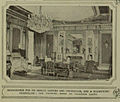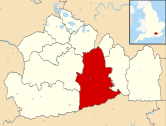Polesden Lacey
| Polesden Lacey | |
|---|---|
 East facade | |
| Type | Country house |
| Location | Great Bookham |
| Coordinates | 51°15′27″N 0°22′25″W / 51.257638°N 0.373728°W |
| Area | Surrey |
| Built | 1824 |
| Architect |
|
| Architectural style(s) | Regency |
| Owner | National Trust |
Listed Building – Grade II* | |
| Official name | Polesden Lacey |
| Designated | 7 September 1951 |
| Reference no. | 1028665 |
Polesden Lacey is an Edwardian house and estate, located on the North Downs at Great Bookham, near Dorking, Surrey, England. It is owned and run by the National Trust and is one of the Trust's most popular properties.
This Regency house was expanded from an earlier building, and extensively remodelled in 1906 by Margaret Greville, a well-known Edwardian hostess. Her collection of fine paintings, furniture, porcelain and silver is displayed in the reception rooms and galleries, as it was at the time of her celebrated house parties.
The 1,400-acre (570 ha) estate includes a walled rose garden, lawns, ancient woodland and landscape walks.
The future George VI and Queen Elizabeth spent part of their honeymoon here in 1923.
Previous houses
The name 'Polesden' is thought to be Old English. The first house was built here by 1336. Anthony Rous bought the estate in 1630 and rebuilt the medieval house.[1] Richard Brinsley Sheridan, the poet and playwright, bought the house in 1804.[2]
The house at one time belonged to Sir Francis Geary, but his Polesden Lacey was demolished when Joseph Bonsor bought the estate and commissioned Thomas Cubitt to build an entirely new house in 1824, creating the core of the house seen today. Bonsor died in 1835, and the house passed to his son who, in 1853, sold the estate to Sir Walter Rockcliff Farquhar, who held it until his death in 1902.
Early 20th Century
The Polesden Lacey estate was purchased in 1902 by Sir Clinton Edward Dawkins, a career civil servant, who commissioned Ambrose Poynter, architect son of Sir Edward Poynter P.R.A., to significantly extend Cubitt's work to create the present house. Sir Clinton, however died shortly after its completion. The estate was then bought in 1906 by William McEwan for his daughter, the former Margaret Anderson, and her husband Captain the Honourable Ronald Greville.

Architects Charles Mewès and Arthur Davis, who were responsible for the Ritz Hotel in London, remodelled the house for the Grevilles. The couple filled the house with collections of fine furniture, porcelain, silver and art.
Ronald Greville died in 1908 only two years after they had moved to Polesden Lacey. He was aged 46.[3] Margaret continued to entertain lavishly at the house. She also owned a home in London in which she held expensive parties. Over the next 30 years her reputation as an Edwardian society hostess became established.
Royal honeymoon at Polesden Lacey in 1923
In 1923 Margaret invited the Duke and Duchess of York to spend their honeymoon at Polesden Lacey and the royal couple subsequently spent two weeks there. Shortly before their arrival a London newspaper took photographs of the house and published a large feature article about the proposed honeymoon venue.[4]
National Trust ownership (1942 – present)

Polesden Lacey was left to the National Trust by Mrs Greville in 1942 in memory of her father, the brewer William McEwan[5] (she was his illegitimate daughter and sole heir[6]). The bequest included approximately 1,000 acres (400 ha) of land along with paintings and items of furniture, which she hoped would form the basis of a future art gallery.[5] The house was first opened to the public by the Trust in August 1946.[7]
In August 1960, a fire destroyed around half of the roof of the property. Several ground floor ceilings were damaged by water during attempts to extinguish the blaze,[8] however the collection of art and furniture was rescued by estate workers.[8][9] The cost of repairs, some £65,000, was covered by insurance and the house reopened to the public on 9 June 1962.[10]
In 1995 the National Trust embarked on a programme of restoration and renovation.[2] In 2008/9 the visitor facilities were fairly extensively re-furbished, with a new car park, cafe, shop and farm shop. It received 347,149 visitors in 2018, placing it in the Trust's top ten most-visited properties.[11]
Some areas of the house are not currently open to the public. This is because in 1942 it was thought that the bedrooms and servants' areas would not be of interest to visitors. The first floor of the mansion is used by the National Trust Regional Office for London and the South East. The old servants' areas (on the ground floor) are used by the Polesden Lacey staff as offices. In the future, it is hoped that more of the mansion will be open to the public. This began in March 2011 with the opening of Mrs Greville's private apartment which had been occupied by the House Manager. The house is open to the public all year round except for Christmas Eve and Christmas Day. On weekday mornings admission is via a short themed tour. By March 2016 the Regional staff were beginning to move out, allowing more rooms to be available for public viewing.[citation needed]
There are a number of walks around the Polesden Lacey estate, especially in the valley that the main house overlooks. The estate includes a Youth Hostel, Tanners Hatch.
The re-modelling of the facilities in 2008–2009 means that the cafe and shop (as well as the walks) can now be accessed without paying for admission.
Polesden Lacey also has open-air performing facilities, which are used during the summer to host various musical and theatrical events. In 2009 there was the Polesden Lacey Festival.[12]
Trivia
- The gardens of this house (and the surrounding countryside) were used as a location for the 1991 Stephen Poliakoff film Close My Eyes.[13]
- The front of this house was used as a location for the 1997 film Shooting Fish.[14]
- Several areas of the house featured in the BBC drama Restless which was shown in December 2012.[citation needed]
- In May 2013, the BBC programme Antiques Roadshow returned to Surrey for the first time since 2009 to film at Polesden Lacey. This was part of Series 36.[15]
References
- ^ Currie, CK (2000). "Polesden Lacey and Ranmore Common estates, near Dorking: an archaeological and historical survey" (PDF). Surrey Archaeological Collections. 87: 49–84. doi:10.5284/1069268.
- ^ a b "History of Polesden Lacey". National Trust. Archived from the original on 4 March 2010. Retrieved 27 February 2010.
- ^ "Captain The Hon. Ronald Greville". The Times. No. 38613. London. 6 April 1908. p. 6.
- ^ Illustrated London News(London, England),Saturday, 28 April 1923
- ^ a b "Polesden Lacey for the Nation". The Times. No. 49402. London. 25 November 1942. p. 7.
- ^ Donnachie, Ian (2004). "McEwan, William (1827–1913)". Oxford Dictionary of National Biography (online ed.). Oxford University Press. doi:10.1093/ref:odnb/50416. (Subscription or UK public library membership required.)
- ^ "Polesden Lacey to be open to the public". The Times. No. 50534. London. 20 August 1946. p. 8.
- ^ a b "Art treasures saved in mansion fire". The Times. No. 54867. London. 3 September 1960. p. 6.
- ^ "The fire at Polesden Lacey". The Times. No. 54867. London. 3 September 1960. p. 14.
- ^ "Polesden Lacey reopened". The Times. No. 554123. London. 8 June 1962. p. 7.
- ^ "ALVA – Association of Leading Visitor Attractions". alva.org.uk. Archived from the original on 23 December 2017. Retrieved 25 August 2019.
- ^ National Trust – Polesden Lacey Festival 2009 Archived 14 May 2009 at the Wayback Machine
- ^ "Close My Eyes (1991) Filming & Production". IMDb. Archived from the original on 23 January 2021. Retrieved 15 August 2018.
- ^ "Shooting Fish (1997) Filming & Production". IMDb. Archived from the original on 23 January 2021. Retrieved 15 August 2018.
- ^ "Polesden Lacey". BBC Antiques Roadshow. Archived from the original on 16 October 2018. Retrieved 15 August 2018.









